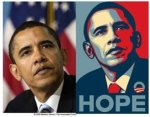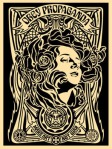“Good artists copy, great artists steal.” April 8, 2009
Posted by stells82 in Art, Uncategorized.trackback
It’s an un-sourced quote from Mister Picasso himself. Just reading it, it seems like a statement promoting plagiarism but if you chew on it for a couple seconds you’ll figure it out. A “good” artist can take a piece of work whether it be a photograph, a painting, a sculpture, or even a song and “copy” it; but a “great” artist can take the same piece of art and mold it into something so profound they have essentially “stolen” the piece by making it a statement of their own. We all know nothing is original anymore. Everything comes from something. There is no such thing as an original concept because it’s all been done before. But somehow new art is emerging everyday.
 Every generation has some type of iconic piece of art that will be remembered through time. One such piece emerged from our recent historic presidential election. It’s a series of Obama campaign posters depicting our new president’s face painted in a red-white-and-blue scheme over the word “hope” or “progress”. If you can’t already see it in your head it’s pictured here for you alongside the original photograph (and I know you’ll recognize it). The poster was created by Shepard Fairey, a well-known street artist. The poster served its purpose very well- our (back then) presidential candidate’s pensive face illustrating the idea of hope so blatantly one can’t help but to be captivated. As of today, the original is hanging in the Smithsonian’s National Portrait Gallery (not bad for a “street artist”).
Every generation has some type of iconic piece of art that will be remembered through time. One such piece emerged from our recent historic presidential election. It’s a series of Obama campaign posters depicting our new president’s face painted in a red-white-and-blue scheme over the word “hope” or “progress”. If you can’t already see it in your head it’s pictured here for you alongside the original photograph (and I know you’ll recognize it). The poster was created by Shepard Fairey, a well-known street artist. The poster served its purpose very well- our (back then) presidential candidate’s pensive face illustrating the idea of hope so blatantly one can’t help but to be captivated. As of today, the original is hanging in the Smithsonian’s National Portrait Gallery (not bad for a “street artist”).Like many of you, I had seen the poster but it wasn’t until I ran across an article in a recent “Rolling Stone” magazine that I realized there was such a huge controversy surrounding the piece. Apparently Fairey’s depiction of Obama was “referenced” from a photograph taken by a man named Mannie Garcia. Garcia was working as a freelance photographer for the Associated Press when he took the photo. After all of the posters’ success the AP has decided to go after Fairey for copyright infringement. While the short article went on to describe Fairey’s new projects geared towards charity, the legal battle Fairey is fighting intrigued me and thus began my head-spinning journey that would take me from the Nazi Gestapo to Family Guy.
I started of course by googling Shepard Fairey and came to find his legal battle with the AP is the topic of choice concerning the artist (so much for charity). Being a graphic design major myself, I am familiar with copyright laws and was not surprised to find Fairey has the more favorable position. The most promising factor in his case is that he is being represented by Stanford Law School’s Fair Use Project so this isn’t the AP vs. the “street artist”; it’s the AP vs. a very prominent movement working to legally protect artists’ right to creative expression. Next comes the sticky part; the terminology involved with copyright law is loose enough to allow plenty of room for interpretation so that every case has to be treated individually. The concept of “fair use” was not included in the original copyright laws and was “developed through a substantial number of court decisions”. There are four factors considered in the classification of “fair use”:
1. The purpose and character of the use, including whether such use is of commercial nature or is for nonprofit educational purposes
2. The nature of the copyrighted work
3. Amount and substantiality of the portion used in relation to the copyrighted work as a whole
4. The effect of the use upon the potential market for or the value of the copyrighted work
While I would love to go into the colorful details of copyright law that served as the bane of my existence during my years as a design student I’m going to make this as simple as possible. In Fairey’s case, factors 1 and 2 come to play together in that the purpose of Garcia’s photograph was to capture a moment for news purposes which typically means capturing a moment in time from a “who-what-when-where-why-perspective” and the purpose of Fairey’s not-for-profit-poster was to create an image of inspiration. The third factor considered for fair use isn’t in Fairey’s favor in my opinion in that if you put the photograph and the poster side by side the portion of the original photograph used in the poster is quite substantial but even then- it’s a picture of a person. The fourth factor is where Fairey’s case really gains momentum. The effect Fairey’s poster has had on the original photograph taken by Garcia is that the original series of photographs signed by Garcia are being sold in a gallery in New York City for $12 hundred a piece (not bad for a freelance photographer). I think it’s also important to point out a few particulars about Mr. Garcia: he is against seeking any legal action against Fairey and has even stated that he never signed any documents granting the AP copyright for any photographs.
This is where I discovered something more to the legal issues plaguing Fairey’s work. Shepard Fairey broke into the art scene with his “André the Giant Has a Posse” campaign in 1986 and the “Obey Giant” campaign in 1989. Both campaigns were experiments in phenomenology and were meant to stimulate the curiosity of the public making them more aware of their surroundings. It turns out Fairey was threatened with a lawsuit for his “André the Giant” campaign for using the trademarked name “André the Giant” and was also forced to alter his representation of André into something “more iconic”. Thus the “Obey Giant” campaign was born.
 The “Obey Giant” campaign became quite a success: the prints sold well and new ones are in high demand, the images have appeared in movies such as “Batman Forever” and “Along Came Polly” and on television (“Family Guy” and “Robot Chicken”), and there’s even a clothing line. But the “Obey” campaign has come under fire via the art community. A number of the “Obey” pieces consist of imagery from various sources such as 1956 film “1984” and even a 1901 Moser print I recognized off the bat. Fairey takes these images and “transforms” them or “incorporates” them into some powerful pieces of art. While I can’t deny Fairey’s pieces are amazing and would look great hanging on a couple of my walls, the similarities between them and the original sources leave a bitter taste in my mouth. The critics are saying Fairey is a “fraud” and a “plagiarist” but I can’t agree fully. Yes, the posters consist primarily of recycled images that are slightly altered if at all but the effect they have is quite powerful. I think the questions we have to answer is whether the effect of the pieces is created by Fairey himself rather than just revamped and if this constitutes as “fair use”. The ultimate irony of the pieces is that the campaign is geared towards making the public more aware of their environment and chances are a decent amount of people have failed to realize the prints or t-shirts they scrambled to buy consist of second-hand artwork. One may be inclined to think some of the negativity aimed at the “Obey” campaign is caused by the amount of success owed to this irony.
The “Obey Giant” campaign became quite a success: the prints sold well and new ones are in high demand, the images have appeared in movies such as “Batman Forever” and “Along Came Polly” and on television (“Family Guy” and “Robot Chicken”), and there’s even a clothing line. But the “Obey” campaign has come under fire via the art community. A number of the “Obey” pieces consist of imagery from various sources such as 1956 film “1984” and even a 1901 Moser print I recognized off the bat. Fairey takes these images and “transforms” them or “incorporates” them into some powerful pieces of art. While I can’t deny Fairey’s pieces are amazing and would look great hanging on a couple of my walls, the similarities between them and the original sources leave a bitter taste in my mouth. The critics are saying Fairey is a “fraud” and a “plagiarist” but I can’t agree fully. Yes, the posters consist primarily of recycled images that are slightly altered if at all but the effect they have is quite powerful. I think the questions we have to answer is whether the effect of the pieces is created by Fairey himself rather than just revamped and if this constitutes as “fair use”. The ultimate irony of the pieces is that the campaign is geared towards making the public more aware of their environment and chances are a decent amount of people have failed to realize the prints or t-shirts they scrambled to buy consist of second-hand artwork. One may be inclined to think some of the negativity aimed at the “Obey” campaign is caused by the amount of success owed to this irony.
 And now comes the final quirk of fate that made me laugh. In fear of making this a novel I’m going to be scarce on the details. A new artist has emerged on the scene creating a campaign using Fairey’s strategy…and images. The most prominent piece consists of Fairey’s now-famous Giant’s face with a SARS mask. The artist, Baxter Orr created the parodies of Fairey’s work to express his cynical opinion of the “Obey” campaign. If Fairey’s methods used to create his art is considered “fair use”, then so are Orr’s…except Fairey doesn’t think so. In 2008 Orr was served with a cease-and-desist letter per Fairey’s request.
And now comes the final quirk of fate that made me laugh. In fear of making this a novel I’m going to be scarce on the details. A new artist has emerged on the scene creating a campaign using Fairey’s strategy…and images. The most prominent piece consists of Fairey’s now-famous Giant’s face with a SARS mask. The artist, Baxter Orr created the parodies of Fairey’s work to express his cynical opinion of the “Obey” campaign. If Fairey’s methods used to create his art is considered “fair use”, then so are Orr’s…except Fairey doesn’t think so. In 2008 Orr was served with a cease-and-desist letter per Fairey’s request.
It all comes back to my original point: there is no such thing as an original concept because it’s all been done before. But the whole point of art is expression. If you as an artist can make people feel something through your work then you have continued the tradition and may just be a “great” artist. The problem with art today is it has become more than just an outlet for expression; it has become a gold mine where the possibility of making some big bank has turned it into nothing more than a day-time soap opera.
awesome stella, tiny suggestion, use bigger images… they captivate more… or at least vary them in size… we went to art school i know you can do this…muua! love the article.